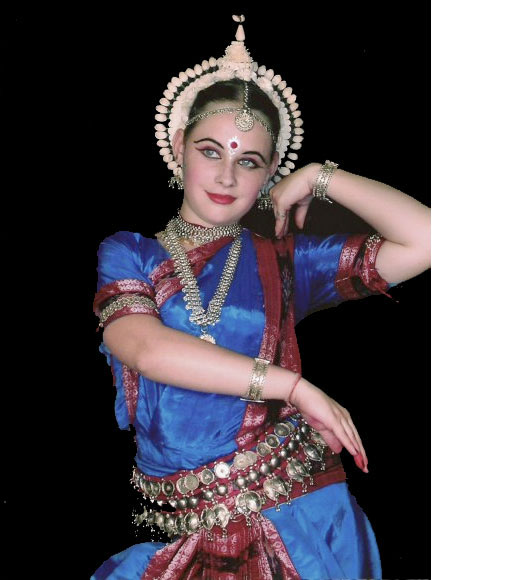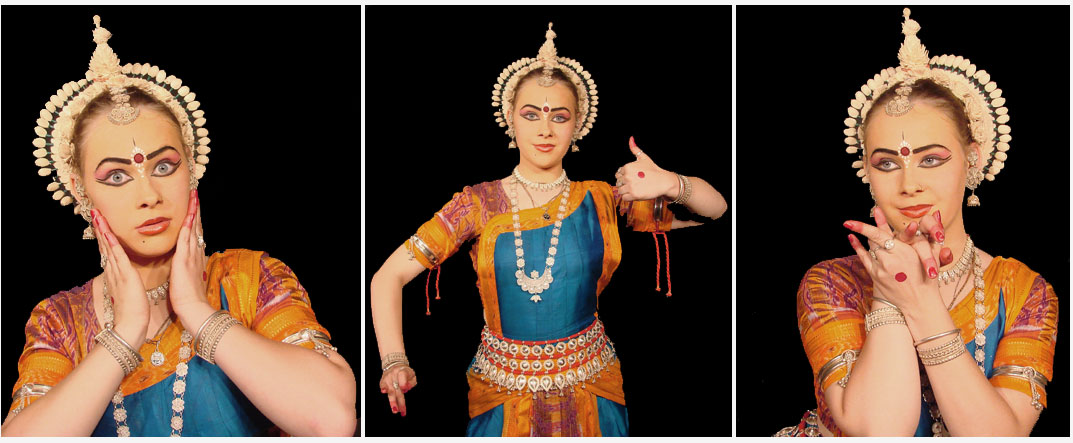
Interview by Kaustubha das
Vrindarani Dasi (originally from St. Petersburg) is a 17 year old student at the Venunad Kala Kendra school of Odissi Dance in Vrindavan, India. Recently I had the pleasure of spending some time with her and her family in their beautiful home in Vrindavan. After an evening of kirtan in their small roof-top temple to Radha Govinda, Vrindarani kindly answered some questions about the classical form of Indian dance called Odissi.
How long have you been dancing?
I have been dancing for practically my entire life. As soon as I started to walk I started to dance. My mother and father were like “wow, our little daughter is dancing!” Then our guru came to our city, saw that I was dancing and told my parents to find me a dance teacher. When I turned 3 years old they gave me to a Bharatnatyam dance teacher. I was practicing Bharatnatyam for three years until the teacher moved away, so I gave-up Bharatnatyam and took-up folk dance. When I was ten I began to practice Odissi and now I have been doing it for seven years. So I can say all my life has been dance.
Among the various styles of classical Indian dance what is particularly special about the Odissi form?
Odissi is the style from Orissa and is considered to be the oldest form of classical Indian dance. It is very closely related to the temple of Lord Jagannath, one of the oldest and most important Krishna temples in India. The Odissi style was developed and performed by girls called devadasis for the pleasure of the deity of Lord Jagannath (Krishna). The devadasis were very devoted. They would never marry. They considered themselves married to Lord Jagannath and would dance in the temple for his pleasure. This dance came from them.
Another special thing about Odissi is that the famous devotional poem Gita Govinda was composed for Odissi dance, with the meter of the beats written to correspond with the dancer’s steps. The dress is also special. Its very colorful and has flowers worn on the head which represent the tower of on the temple of Lord Jagannath.
The steps are unique because they include Krishna postures like tribhanga which involves bending the body in three places (neck, torso and knees) creating very expressive and beautiful forms. These postures are represented in the sculptures found carved in the walls and pillars of ancient temples. Seeing a good Odissi dancer feels like seeing a sculpture come to life. Subtle facial expressions and mudras (hand gestures) are also used to convey a wide range of emotions needed to make the lilas (pastimes) of Krishna come alive on stage.
Could you describe how this dance relates to bhakti?
I can say, for myself personally, that when I dance I feel that I perform it for my Lord. So I feel very fortunate and happy. When I feel happiness I want to do more and serve more for my Lord. So its like when you love something, and you do it with love, you want to continue (laughter). It really helps me in my seva (devotional service) also, because so many realizations about the nature of devotion come to me through dance. If the dance is very well done, showing all the subtle expressions, then a bhava (a feeling of devotion) is coming to the audience as well. Because when they see it they feel it, and when they feel it they like it. When they like it they also feel all these emotions.
Sometimes you play the role of Srimati Radharani, particularly in the Rasa-lila. In that role you are searching for Krishna in a deep mood of separation which, in Vaishnava theology, is understood to be extremely rare and is revered as the very peak of human consciousness and the highest stage of yoga. How do you prepare to play that role? How does it affect you, and are there things you do to try to understand it?
Before I was playing the role of Radharani I began praying so much to the Lord. To play Krishna is actually much easier. When my teacher asked me to play Radharani I was shocked as it is such a difficult role to play. You really have to try to understand her mood. It is very esoteric so I was praying so much, “O Radharani, please, I don’t understand you at all. How am I going to dance?” And then somehow, I don’t know why, I got a little hint of what kind of expression I should use in Radharani’s role. And when I started to dance… I don’t know, but maybe it was Radharani’s mercy. I felt that someone had entered my heart and was just playing inside of my heart. It was really special and all the emotions just came out of me like that.
You’ve had the honor to dance in front of the Krishna deity Sri Radharaman at the Radharaman Temple in Vrindavan, which is noted for it’s rich devotional history and the preservation of culture and tradition. How does it feel to dance there?
Sri Radharaman is one of my favorite deities in Vrindavana. I always appreciate it when I get the opportunity to dance before him. It is really special mercy. When you dance before him you feel that he is very happy, and that he is also dancing with you!
